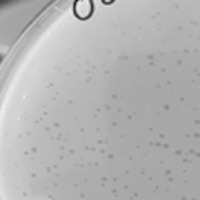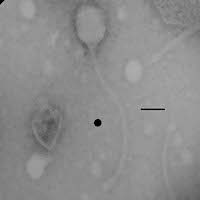Mycobacterium phage FortLev
Know something about this phage that we don't? Modify its data.
| Detailed Information for Phage FortLev | |
| Discovery Information | |
| Isolation Host | Mycobacterium smegmatis mc²155 |
| Found By | Alexandra Fortino and Anna Levine |
| Year Found | 2019 |
| Location Found | Northampton, MA United States |
| Finding Institution | Smith College |
| Program | Science Education Alliance-Phage Hunters Advancing Genomics and Evolutionary Science |
| From enriched soil sample? | Yes |
| Isolation Temperature | 37°C |
| GPS Coordinates | 42.3 N, 72.6 W Map |
| Discovery Notes | We collected soil outside of Lamont House on Smith College Campus. GPS Coordinates: 42.319938 N, -72.63701 W Soil was dark in color, mulchy, and dry. |
| Naming Notes | We used our last names in order to name the phage. |
| Sequencing Information | |
| Sequencing Complete? | No |
| Sequencing Facility | Smith College |
| Shotgun Sequencing Method | Illumina |
| Genome length (bp) | Unknown |
| Character of genome ends | Unknown |
| Fasta file available? | No |
| Characterization | |
| Cluster | Unclustered |
| Subcluster | -- |
| Lysogeny Notes | Based on the morphology of plaques formed by the phage, we have a temperate phage. Temperate phages can stay dormant in bacteria. Some temperate phages need extra time to activate the lytic cycle. The difference in time activated between the temperate phages going through the lytic cycle and dormant temperate phages causes the haziness of the plaques. Only some of the temperate phages are activated to destroy the bacterial lawn. |
| Annotating Institution | Unknown or unassigned |
| Annotation Status | Not sequenced |
| Plaque Notes | We have multiple isolated plaques on the Dilution 10-2 plate. All of the plaque morphologies are round, turbid dots, which makes them most likely the same phage. The phage is most likely temperate because the dots are unclear and hazy. The plaques are very tiny, no more than 0.5 cm in diameter. Dilution -3 had 17280 plaques. |
| Morphotype | Siphoviridae |
| Has been Phamerated? | No |
| Publication Info | |
| Uploaded to GenBank? | No |
| GenBank Accession | None yet |
| Refseq Number | None yet |
| Archiving Info | |
| Archiving status | Not in Pitt Archives |
| Available Files | |
| Plaque Picture | Download |
| EM Picture | Download |

